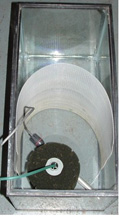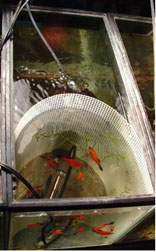Saving baby livebearers is something most of us plan to do from the first time we buy a pair of guppies, platys, swordtails, mollies, least killifish or exotic livebearer. Then we wonder what to do when we first notice that the female is pregnant. In a well-planted tank with only a few adult fish some babies will survive. In fact, in any well-planted tank with only a very few fish you will eventually find a few babies of almost any species. But then, a well-planted tank with few fish is not what most of us normally have. If you are like me, you have as many fish as you can justify in the tank regardless of whether it is well planted or decorated only with rocks. Under these circumstances we never see even a glimpse of a baby, well, maybe a fleeting glimpse of one hiding in a floating plant or in a rock crevasse. But they don’t last long.
So in the evolution from a fish keeper to a breeder of tropical fish, a key step is to recognize when to move the pregnant fish to someplace where the babies can be saved. If we do nothing, we get no cute little fish. And who does not want to say I raised these guppies, these mosquito fish (really), those red velvet swordtails, those xiphophorus maculatus or those anableps anableps (yes, four eyes are really livebearers).
Isolating the Pregnant Fish
The obvious thing to do is to take the pregnant fish out of the display tank and put her in a tank by herself. Oh, you can buy a breeder trap that can be hung inside the display tank. It has slots in it that allow the water in the main tank to circulate through the breeder trap. There is another design that is a rectangular box with sides and bottom of fish netting. The only advantage of these breeder traps is that the water quality of the main tank is the same as in the breeder trap, and this is good for the pregnant fish and any fry she drops.
The bad part of these traps is that they are small and can cause the female much distress as can be seen if she is continually rubbing her nose against the walls. And you cannot feed the fish in this breeding trap without it quickly fouling, mainly because the female is too stressed to eat.A better solution is to set up a five- or ten-gallon tank with abundant plants and a filter and heater to provide temperature and water quality similar to or better than the tank from which she came. Sponge filters are best. They do not suck up the babies, as can be the case with mechanical filtration like hang-on-the-back power filters or set-on-the floor canister filters. The old-style box filters that use angel-hair floss as filter medium and air bubbles to pull the water through also work well.
The amount of babies saved by such a tank depends on the disposition of the female, that is, how hungry she is, and on how many plants are provided; the more the better. Babies when first born tend to either swim as close to the surface of the water as they can or to go to the bottom and hide in the stuff at the bottom. So the plants you provide should encompass both areas. I personally like to use an abundance of hornwort, which is a floating plant. But, if you put in enough of it at one end of the baby-saving tank, it will fill the tank from top to bottom.Babies, particularly when first born, have a great survival instinct, likely an unconscious desire not to be eaten. Most have very quick, reflexive action to flee on being approached by any fish or object that is bigger than they are, even a shadow. And so, usually they get away. But they cannot keep up this fleeing motion for very long, definitely not continuously. They are good for a few milliseconds of escape mode, which is time enough for rapid fin and tail motion to get them to cover. But then they need to rest and maybe time to get their first bite of something to eat. Until they get that first bite they are still living off of their original egg yoke and that is gone, or mostly used up by the time they were born into whatever situation they find themselves. In your tanks, this situation depends on you.
Babies in a tank with more than a few adult fish have little chance of survival. When one adult gives chase and the fry eludes it, by chance the fry will have been chased into the view of another adult. Disaster, as far as the fry is concerned, or good fortune, as far as the adult fish sees it, can be seen as inevitable. Occasionally a fry or two survive unexpectedly in a main tank. This is survival of the fittest fry.
The separate tank with plants, filter, and heater with one pregnant fish in it seems to be the ideal solution. It is, as far as it goes. But you know that is not how we modern fish keepers do things.
We find we have pregnant guppies and swordtails at the same time. This leads to two or more pregnant females in the tank meant to be the saver of babies. This still works fairly well. In this set up you can estimate that about a third of the babies born will be saved, provided you pay attention and remove the babies ASAP. Oh, so now we need another tank. Oh, and that reminds me, I have a number of used ten-gallon tanks for sale.
I have been in the fish hobby for years, and I have tried all sorts of contraptions, set-ups, and devices to save and allow growth of newly born livebearers. On the point about raising the fry to adult size, food is obviously important, but that is another story that will be covered in a separate article ( Part 2: Raising Livebearer Babies).
Baby-Saver Setup
As far as saving babies, I found a way to have multiple pregnant females in the baby-saving tank while saving the majority of the newborn fry, not based on the counting of the number born, which I have witnessed only a couple times, but based on the actual number that survive a couple of weeks. And all of this can be done in the same tank in which they were born. The solution I found is based on a divider made of translucent-white plastic and is sold in fabric/craft shops like Jo-Ann’s for needlepoint projects. The material is sold as Darice “Artist GIANT plastic canvas” in various mesh sizes. I like the 13 ¼-inch by 22-inch in size 5 mesh. Choose a mesh of a size thatyour fry can swim through. To install it in your tank cut the sheet with a pair of scissors to fit the height of the tank.
There is no need for clamps or devices to hold the mesh in place. Simply bend the sheet into a U-shape (see Figure 1) and it will stay in place in a five, ten or fifteen-gallon aquarium indefinitely, held in place by the top frame of the tank and the springiness of the canvas.
I place the pregnant fish on the inner side of the U (see Figure 2). If placed on the outer side of the U, the adult fish can and will get caught in the wedge shaped spaces between the divider and the tank glass. Bummer.
I still use some hornwort in this set up (as in Figure 3), but it is not essential. It does help keep the nitrate level down by consuming nitrate. And it does help save some babies particularly if placed on the same side as the adults. And it helps the adults feel more at ease.
I can put a half dozen, even more females in various stages of pregnancy into such a set up and not only save the babies but raise the babies to a size that they become too big to fit through the holes in the divider. In one current set up as described, I have fry of different sizes from at least three different females.
In previous non-divider set ups using plants only, even with tons of plants filling more than half of the space, I would get less than a third of the young fish that I get with the divider. Based solely on the numbers of babies saved and grown to a quarter of adult size, this divider method is very successful. Red wag females do not really show their pregnancy, so it is hard to know when to put them in the baby-save tank. With the tank described the female can be put in early. They often drop between 20 and 30 fry each time. Blue spotted platys tend to drop about the same number. Surprisingly I was also able to use this method to successfully get a batch of baby zebra danios without ever removing the parents.
January 16, 2009



